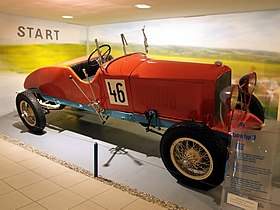Tatra 10
Appearance
This article relies largely or entirely on a single source. (March 2019) |
| Nesselsdorfer Wagenbau-Fabriks-Gesellschaft Type U Tatra 10 | |
|---|---|
 | |
| Overview | |
| Manufacturer | Nesselsdorfer Wagenbau-Fabriks-Gesellschaft A.G. today Tatra, a.s. |
| Production | 1915 - 1918 NW U (10 produced) 1919 - 1927 Tatra 10 (129 produced) |
| Assembly | Kopřivnice, Moravia |
| Designer | Hans Ledwinka |
| Body and chassis | |
| Body style | diverse four or six seaters |
| Layout | FR layout |
| Related | NW T (Tatra 20) |
| Powertrain | |
| Engine | 5.3L NW U I6 |
| Transmission | 4-speed manual |
| Dimensions | |
| Wheelbase | 3,635 mm (143.1 in) |
| Length | 4,900 mm (192.9 in) |
| Width | 1,800 mm (70.9 in) |
| Curb weight |
|
| Chronology | |
| Predecessor | NW S |
| Successor | Tatra 17 |
The NW type U is an Edwardian era automobile manufactured by Nesselsdorfer Wagenbau-Fabriks-Gesellschaft A.G. (NW, now known as Tatra). After the success of Type S, models NW T (four-cylinder) and NW U (six-cylinder) were launched. Both types were again OHC design with hemispherical combustion chambers with the cylinders cast in one piece with the engine block.

As the company changed its name the model was renamed to Tatra 10 in 1919. The production version was able to reach 120 kilometres per hour (75 mph).
The Type U was fitted with brakes on all four wheels, probably the first production car in the world with such brake system.[1]
References
